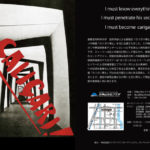“Yankee and Otaku” is a video installation work. Yankee, which reproduces the work of Jackson Pollock, refers to a slang term originally from North American, but has come to include the iconic stereotypes of the Japanese bad boy and bad girl. The Japanese Yankee often comes from circumstances of poverty, family neglect and domestic violence. Mizushima sets the stage, an area reclaimed as a military industry site during WWII, which remains one of the most important industrial producers in Japan. After 2000, the Yankee has been influenced by American Hiphop and gangster culture. With social segmentalization, however, few Yankees are seen in Japan.
Symbolic to the transformation of high and low culture as represented in the Comic market, Otaku refers to people who are addicted to comics, animation, games, computers, SF and figures. There products continuing appropriated and reproduced. Most Otaku are from the middle class and experience exclusion from school, community and society at large. They gather together and create individual new markets. Otaku may also influence the direction of consumption culture as collectors.

Yankee and Otaku
Video Installation
2 channel.
Duration: 7:56 minutes, loop
Dimensions: variable.
2014
Mizushima Complex
The film Investigates the history of immigrant workers settled in the Mizushima Industrial Zone from WW II to the present, rendering the perspectives of colonialism, imperialism, migration, nationalism, and globalization in Asia. Based on the primary sources collected in its research phase, the work attempts cross-sectional consideration by trilogy:
1) immigrant workers in the pre-war and during WWII;
2) immigrant workers in the postwar to the present time;
3) female immigrant workers.
Chapter 1 considers the actual conditions of Japanese trainers and Korean trainees through surveys and interviews with the survivors, making visual experiences of often conflicting backgrounds of both nationals during WWII.
The film Investigates the history of immigrant workers settled in the Mizushima Industrial Zone from WW II to the present, rendering the perspectives of colonialism, imperialism, migration, nationalism, and globalization in Asia. Based on the primary sources collected in its research phase, the work attempts cross-sectional consideration by trilogy:
1) immigrant workers in the pre-war and during WWII;
2) immigrant workers in the postwar to the present time;
3) female immigrant workers.
Chapter 1 considers the actual conditions of Japanese trainers and Korean trainees through surveys and interviews with the survivors, making visual experiences of often conflicting backgrounds of both nationals during WWII.
Mizuhiam Complex Chapter 1
Video Installation.
Single channel.
Duration: 26:42 minutes.
Dimensions: variable.
2015
Chapter 2 consists of interviews with Brazilian residents in Japan and their descendants who settled after amendment to the Japanese Immigration Control Law in 1990, as well as Chinese and Vietnamese who traveled to Japan under the immigrant workers training system.
Mizuhiam Complex Chapter 2
Video Installation.
Single channel.
Duration: 31:51 minutes.
Dimensions: variable.
2016
Chapter 3 consists of immigrant Filipino women engaged in the sex industry in the Mizushima area against the landscape of their hometown.
Mizuhiam Complex Chapter 3
Video Installation.
Single channel.
Duration: 26:22 minutes.
Dimensions: variable.
2017
Voice 1, 2
“Voice 1 and 2” are single video installation works focusing on foreign laborers participating in the Japanese Technical Internship Training system, which is a government initiative established to transfer technology from Japan to less economically advantaged countries. While the intent is to benefit economic development of a participating country, in practice it provides Japanese industry cheap foreign labor in a tightly controlled environment. Technical Intern Trainees in Japan suffer from workplace abuse, low wages and unsatisfactory living conditions.
This work uses the voices of foreign laborers in Japan who are participating in Japanese speech contests sponsored by the training program. The video focuses on the internalization of obedience among trainees which is instituted through Japanese political coercion and the educational system.

Voice 1
Video Installation.
Single channel.
Duration: 2:23 minutes,loop.
Dimensions: variable.
2018

Voice 2
Video Installation.
Single channel.
Duration: 1:57 minutes,loop.
Dimensions: variable.
2018





